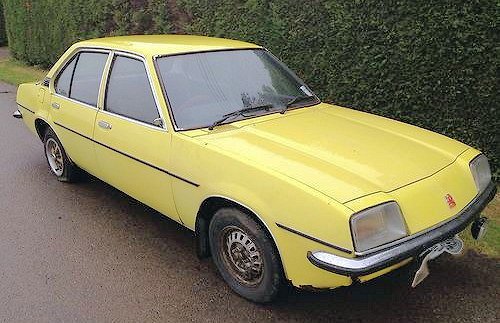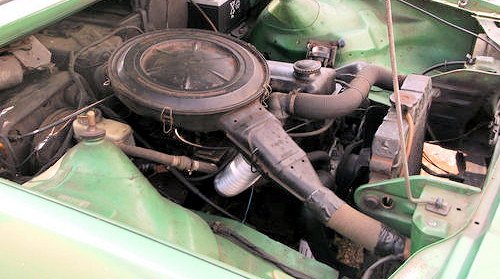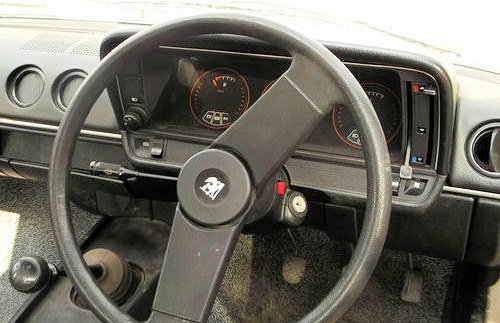Vauxhall Cavalier Mk1 - Opel Ascona B
 | |
Production period: | 1975 to 1981 |
Class : | motor car |
Body versions : | saloon |
Engines: | Gasoline : 1.2-2.0 liters (40-81 kW) |
Length: | 4321 mm |
Width: | 1670 mm |
Height: | 1380 mm |
Wheelbase : | 2518 mm |
Curb weight : | 900-1100 kg |
The Opel Ascona B also as the Vauxhall Cavalier Mk1 in the UK is a mid- size sedan from Opel, and was presented in September 1975. This was the successor to the built in November 1970 Ascona A and the last Ascona on the GM-H platform with rear-wheel drive .
History
The Ascona B has also been sold in the UK and other countries (eg Sweden ) as Vauxhall Cavalier . This model was equipped with the front of the Opel Manta B and thus had an independent appearance. The Cavalier ran in the General Motors factory Antwerp, later in the Vauxhall factory in Luton, England from the band, and was available from August 1977 with the 1256 cc four-cylinder engine developed by Vauxhall.
In South Africa, the Chevrolet Chevair visually equivalent to the Cavalier was offered from November 1976 with 56.5 and 63 kW strong (77 and 86 hp) 2.0 and 2.3-liter four-cylinders. From July 1978, there was also the Chevrolet Ascona, which outwardly resembled the German Ascona, but was equipped with a 1256-cc four-cylinder from the Vauxhall Viva with 40 or 42 kW (54 or 57 hp).

The Opel Ascona B had the same technology as the Opel Manta B coupe presented at the same time .The two- or four-door sedan was made in Bochum and Antwerp , a combined version ("Caravan") as the Ascona A did not exist. In the UK , the type was offered as a right-hand drive with a Manta B equivalent front end under the name Vauxhall Cavalier Mk. 1 . In South Africa , the model was as Chevrolet Ascona and Chevrolet Chevair on the market.
The successor to the Ascona A presented at the IAA in 1975 differed from its predecessor by a smoother look. The Opel Ascona was only available as a two- and four-door sedan, with a combination variant (as it was still available on the previous model) was now waived.
Initially, there was the type with the well-known from the predecessor four-cylinder in-line engines, but partly made a little less because of more stringent exhaust gas regulations. The petrol engine had 1.2 to 2.0 liters of displacement 44 to 81 kW (60 to 110 hp) and the two-liter diesel came to 43 kW (58 hp). In addition, there was the Ascona SR a sporty-inspired equipment line in the program, but only with 1.6-liter, 1.9-liter and 2.0-liter engine.
The Ascona B was visibly more spacious designed than the Ascona A, which was originally designed as a successor to the Cadet B and was placed in the course of its development as a new mid-range series on the market. The wheelbase was extended by 8.8 cm, the body grew by 20 cm in length and 4 cm in width, it was half a centimeter lower. The appearance of the Ascona B corresponds to the Opel design of the 1970s with smooth body and large glass areas and the Rekord D and the Kadett C.
The tank was crash-proof behind the rear seat, which also made the trunk larger than its predecessor. The 1.2-liter engine with side camshaft based on the engine of mid-1962 presented Kadett A , while the larger based on the CIH engine of mid-1965 introduced record B.
Starting in August 1976, the 1.2-liter N-engine with 40 kW (55 hp), but like the newly offered and 55 kW (75 hp) strong 1.9-liter N-engine with regular gasoline got out. From September 1977 replaced the 2.0-liter S with hydraulic tappets and 74 kW (100 hp), the 1.9-liter S-engine, in March 1978, followed by the 2.0-liter N with 66 kW (90 hp ), which was also equipped with hydraulic tappets.
For the first time there was a new 2.0-liter diesel Opel engine with 43 kW (58 hp) for the Ascona from September 1978, which was also available with automatic transmission. Similar to the record E, the diesel required a characteristic hump on the bonnet because the engine was slightly higher. The 1.6 S fell in the summer of 1977 from the program. All models had now as standard an electric windscreen washer.
In February 1979, the models 1.3 N with 44 kW (60 hp) and 1.3 S with 55 kW (75 hp) were added. These had newly developed engines with Alloy - Crossflow Cylinder Head and Overhead Camshaft (OHC). They replaced the technically outdated OHV engine, which had been developed for the Opel Kadett A in the late 1950s. The mixture preparation of the 1.3 S took over as a 2.0 N and 2.0 S a downdraft register carburetor GMF Varajet II (Varajet - "Variable Nozzle") from the French GM production, the 1.3 N still had the Solex PDSI from the OHV or normal petrol models.
In August 1979 slight detail changes were made. The Ascona got a grille with larger air intake slots and bumpers with black plastic sheathing instead of the previous made of chromed steel with rubber strip.From January 1980, the 2.0 E-CIH engine (E stands for the L-Jetronic injection from Bosch) with 81 kW (110 hp) already introduced in August 1977 for the Manta and Rekord E models was also available for the Ascona , In January 1981, Opel deleted the engines 1.9 N and 2.0 N from the engine range.In August 1981, the production ended in favor of a front-wheel drive upgraded successor the Opel Ascona C .

Ascona 400
From August 1979 the Ascona 400 was at the rally a special sports version of Opel Three achievements. The number required for homologation flowed into the name: Ascona 400. With the type Walter Röhrl won the 1982 World Rally Championship . The car had a Getrag five- speed gearbox; the rear central joint axis was replaced by the rigid axle used in the record or Commodorewith four pairs of equally long trailing arms and Panhard rod . There were several tuning kits in different power levels, called Phase I to III. The basic engine formed a 106 kW (144 hp) 2.4-liter, four-valve cross-flow - the cylinder head . The suspension was also revised at the Ascona 400.
Ascona i2000
Another sporty model was the Ascona i2000, built in 1979 in cooperation with the company Irmscher Automobilbau , which could be equipped with a dual carburettor system on request and at extra cost. As a result, the power increased from 74 kW (100 hp) to 88 kW (120 hp). The model was based on the 2.0 SR, had front ventilated disc brakes and was delivered only in yellow / white.
Rating
Technical
-
Vauxhall Cavalier Mk1 - Opel Ascona B Technical data (1975-1981)
Opel Ascona:
1.2 N
(1976-1979)1.2 S
(1975-1979)1.3 N
(1979-1981)1.3 S
(1981)1.6 N
(1975-1981)1.6 S
(1975-1976)Engine:
4-cylinder in-line engine (four-stroke)
displacement:
1196 cc
1297 cc
1584 cc
Bore × stroke:
79 mm × 61 mm
75 mm × 73.4 mm
85 mm × 69.8 mm
Power at 1 / min:
40 kW
(55 hp)
at 540044 kW
(60 hp)
at 540044 kW
(60 hp)
at 580055 kW
(75 hp)
at 580044 kW
(60 hp)
at 500055 kW
(75 hp)
at 5800Max. Torque at 1 / min:
83 Nm at 3400
88 Nm at 3400
94 Nm at 3800
96 Nm at 4200
103 Nm at 3400
115 Nm at 3800
Compression:
7.8: 1
9.0: 1
8.2: 1
9.2: 1
8.0: 1
8.8: 1
Fuel supply:
1 downdraft carburetor Solex 35 PDSI
1 register downdraft carburetor Varajet II
1 downdraft carburetor Solex 35 PDSI
1 register downdraft carburetor Solex 32/32 DIDTA
Valve control:
Hanging valves, bumpers and rocker arms (side camshaft, roller chain)
Hanging valves, rocker arms (overhead camshaft, timing belt)
Hanging valves, tappets, rocker arms (overhead camshaft, duplex chain)
Cooling:
water cooling
Transmission:
Fully synchronized 4-speed gearbox, stick shift, optional Opel three-speed automatic transmission
Front suspension:
Independent suspension on double wishbones , coil springs
Rear suspension:
Central joint axle ( rigid axle with drawbar) on two trailing arms , Panhard rod , coil springs
brakes:
Hydraulic two-circuit brake system with brake booster, disc brakes 238 mm solid front, drum brakes rear
Body:
Sheet steel, self-supporting
Track front / rear:
1370/1375 mm
Wheelbase:
2518 mm
Length:
4321 mm
Width:
1670 mm
Height:
1380 mm
Empty weight:
900-940 kg
930-1000 kg
960-1000 kg
980-1020 kg
maximum speed:
138 km / h
140 km / h
144 km / h
155 km / h
145 km / h
155 km / h
0-100 km / h:
20.5 s
18.5 s
19.0 s
17.0 s
17.0 s
14.0 s
Consumption (liters / 100 kilometers):
9.0 N
9.0 S
10.0 N
10.0 S
11.0 N
11.5 s
Opel Ascona:
1.9 N
(1976-1980)1.9s
(1975-1978)2.0 N
(1978-1980)2.0 S
(1977-1981)2.0 E
(1980-1981)2.0 Diesel
(1978-1981)400
(1979-1981)Engine:
4-cylinder in-line engine (four-stroke)
displacement:
1897 cm³
1979 cm³
1988 cm³
2410 cc
Bore × stroke:
93 mm × 69.8 mm
95 mm × 69.8 mm
86.5 mm × 85 mm
95 mm × 85 mm
Power at 1 / min:
55 kW
(75 hp)
at 480066 kW
(90 hp)
at 480066 kW
(90 hp)
at 520074 kW
(100 hp)
at 540081 kW
(110 hp)
at 540043 kW
(58 hp)
at 4200106 kW
(144 hp)
at 5200Max. Torque at 1 / min:
132 Nm at 3400
147 Nm at 3800
142 Nm at 3800
151 Nm at 3800
159 Nm at 3400
115 Nm at 2400
210 Nm at 3800
Compression:
7.9: 1
8.8: 1
8.0: 1
9.0: 1
9.4: 1
22.0: 1
9.7: 1
Fuel supply:
1 downdraft carburetor Solex 35 PDSI
1 register downdraft carburetor Zenith 35/40 INAT
1 register downdraft carburetor Varajet II
Electronic injection (L-, later LE-Jetronic)
Bosch diesel injection pump
Electronic injection
Valve control:
Hanging valves, tappets, rocker arms (overhead camshaft, duplex chain)
Hanging valves, hydraulic rams, rocker arms (overhead camshaft, duplex chain)
DOHC 16V
Cooling:
water cooling
Transmission:
Fully synchronized 4-speed gearbox, stick shift, optional Opel three-speed automatic transmission
Fully synchronized 5-speed gearbox (Getrag), stick control
Front suspension:
Independent suspension on double wishbones , coil springs
Rear suspension:
Central joint axle ( rigid axle with drawbar) on two trailing arms , Panhard rod , coil springs
Rigid axle with four trailing links, Panhard rod
brakes:
Hydraulic two-circuit brake system with brake booster, disc brakes 238 mm solid front, drum brakes rear
Body:
Sheet steel, self-supporting
Track front / rear:
1370/1375 mm
1380/1375 mm
Wheelbase:
2518 mm
Length:
4321 mm
Width:
1670 mm
Height:
1380 mm
Empty weight:
1000-1070 kg
1060-1080 kg
maximum speed:
155 km / h
165 km / h
167 km / h
175 km / h
182 km / h
137 km / h
197 km / h
0-100 km / h:
15 s
12 s
12 s
11.5 s
10.5 s
22 s
7.7 s
Consumption (liters / 100 kilometers):
12.0 N
11.0 s
11.0 N
11.5 s
11.5 s
9.0 D
-



